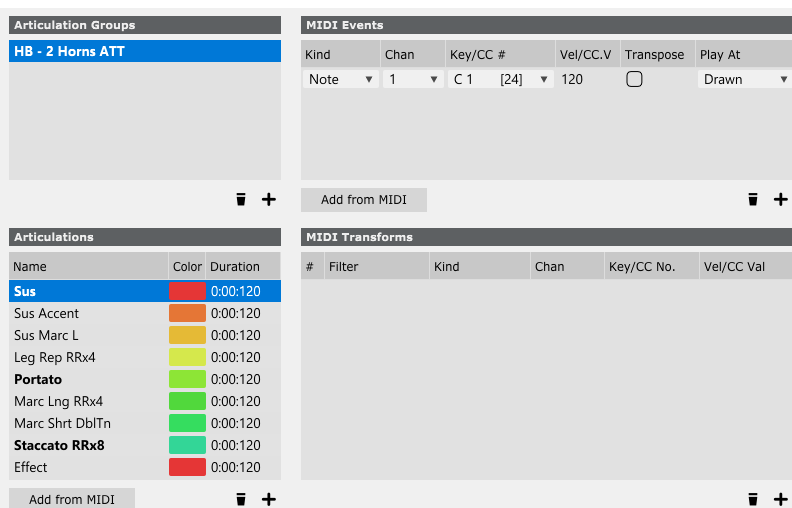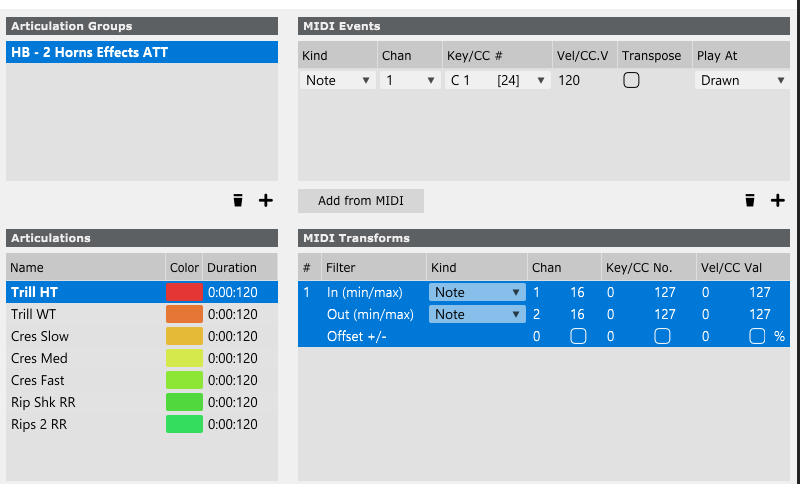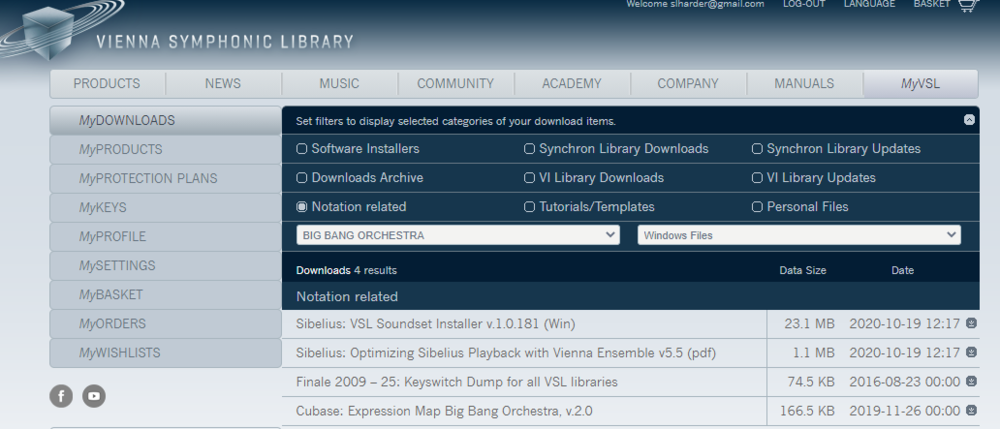-
Posts
242 -
Joined
-
Last visited
-
Days Won
1
Everything posted by Steve Harder
-

[CLOSED] Cakewalk 2020.10 Early Access
Steve Harder replied to Morten Saether's topic in Early Access Program
Request to forum admins to create a dedicated location for user created articulation maps to upload for sharing. And a dedicated location for links to other online sources of articulation maps. Loving maps so far, still in the "drinking from firehose" phase. -
EW Hollywood Brass have at least two keyswitch patches in every instrument. Some of the other Hollywood libraries also have keyswitched patches. This linked article uses Cinematic Strings as an example but the same general technique can be applied to Hollywood. https://medium.com/pragmatic-sound/how-to-create-expression-maps-for-cinematic-studio-strings-ae8963cf1896 The general strategy would be to load all of the target keyswitch patches in one instance of Play, each with a different midi channel #. Then write the Cakewalk articulation map to address specific midi channel. This is Play setup for 2 Trumpets This is Editor for the 2 TP KS Sus patch This is the editor for the 2TP KS Effects patch This is the Articulation Lane Because the articulations in the two patches are exclusive they could all reside in one articulation group. But I had imported them as 2 groups and I haven't researched how to transfer them into one group in the editor. You can get a jump start on this by downloading the Cubase exp map for Hollywood Brass from https://arpegiah.com/expression-maps/ You will get a DIR directory and an ATT directory, Use the DIR directory (even though I accidentally didn't for my print screens.
-
Topic says it all. Multiple strategies are going to be needed as we start creating maps. Cinesamples can use velocity to control articulations. Cinematic uses CC. VSL Synchron uses 3 or 4 keyswitches in tandem. The list goes on. Lots can be learned by importing Cubase maps but not everything is going to translate. ##### https://medium.com/pragmatic-sound/how-to-create-expression-maps-for-cinematic-studio-strings-ae8963cf1896
-

[CLOSED] Cakewalk 2020.10 Early Access
Steve Harder replied to Morten Saether's topic in Early Access Program
Sometimes to sort these issues out you have to dig down and find what midi note NUMBER your daw and each sample library THINKS middle C is. Then you can fix the issue by making an adjustment in the midi track, or the base octave or in the sample library. But there is a lot of variation. -

[CLOSED] Cakewalk 2020.10 Early Access
Steve Harder replied to Morten Saether's topic in Early Access Program
I am totally for open source sharing of community created efforts but I am wonder what Babylonwaves' terms of usage say? They have put a lot of hard work into a product they sell. I don't want Cakewalk to be seen as means to a possibly improper use of someone's licensed product. -

Understanding Cubase expression maps
Steve Harder replied to Steve Harder's topic in Cakewalk by BandLab
I'm about to reach the "trying to drink from a firehose" stage as I dive into expression maps. The capability to import Cubase maps really turned on the flow. Let's all continue to share what we learn about how Cakewalk translates Cubase maps during import. That will help us understand Cubase documentation and how we use it to jumpstart Cakewalk maps. Msmcleod provided an important fact, "CbB articulation maps are for the most part like Direction expression maps." -

Cubase Expression Map list for importing into Cakewalk.
Steve Harder replied to Steve Harder's topic in Cakewalk by BandLab
I took a guess in this other thread. I'm about to reach the "trying to drink from a firehose" stage as I dive into expression maps. The capability to import Cubase maps really turned on the flow. -

Understanding Cubase expression maps
Steve Harder replied to Steve Harder's topic in Cakewalk by BandLab
Thanks, that will point me in the right direction. A couple of the Cubase map packs offered both types, I imported both into CW and didn't see any differences. Possibly your import process cleans up any loose ends. Certainly lots and lots to learn here. -

Looking for a sample project to study (midi)
Steve Harder replied to Gary Freedman's topic in Cakewalk by BandLab
Tonight I'll try to come up with some links for you. I strongly encourage you to check out the Creative Sauce youtube channel. https://www.youtube.com/c/CreativeSauce You'll need to look back a couple of years to find the "basic" vids. He uses Cakewalk in most of the vids so it's easy to learn and apply. Excellent material, and he is a member on this forum. -
Because importing a Cubase expression map is a good jumpstart into articulation mapping I've been studying how they are used and created. Cubase expression maps come in 2 flavors. So here's an explanation that helped me. "Expression maps have two 'articulation types' - Direction or Attribute. Direction works like a latch keyswitch where you trigger it once and all future notes will follow that articulation until you trigger a different one. Attribute works on a per-note basis, letting you choose a different articulation for each note."
-
These are the first steps I took to explore articulation maps. I wanted a sample library that I already had a little experience with. Link to list of downloads I already had the free BBCSO Discover, so I downloaded the free articulation maps for it from https://www.babylonwaves.com/2020/05/07/free-art-conductor-for-spitfire-bbcso-discovery/ The first issue I had within the maps (not a Cakewalk issue) was the first articulation for every instrument was left as empty in the map. This is the print screen for the 2nd listed articulation Pizzicato and you see info in the Midi Events window at upper left. The Long articulation had no Midi Events shown, so I clicked the + and filled in fields with comparable data from Pizzicato. Key/CC I guessed correctly as C-1. There may be a reason why Long was left undefined, maybe a "default if no attribute assigned" exists somewhere?? So I got on with entering notes and articulations and exploring. ### Downloaded Hollywood Brass from https://arpegiah.com/expression-maps/ you get attributes and effects and they work. These are a lot meatier with more to work with and learn from. You do get 2 directories, one is Attribute and other is Direction, they seem to have identical content but I may be missing something. Need to research that more. Lots here for EastWest ComposerCloud subscribers.
-

2020.10 can import Cubase articulation maps!!
Steve Harder replied to Steve Harder's topic in Cakewalk by BandLab
Noel, can you comment on using Babylonwaves Art Conductor with Cakewalk? As best I can determine Art Conductor is just a coordinated set of Cubase Expression maps that you use by just loading maps into Cubase. It seems very reasonably priced at 68Eur for a huge list of maps. Or can anyone else with experience with Art Conductor comment? ### And sort of answered my own question by downloading a free BBCSO from Art Conductor and it imported right into Cakewalk. -
Let's start a list of sources for Cubase Expression Maps. It is important to note that some expression maps are sold by private creators and should not be shared. But many sample library publishers provide free downloads of Cubase expression maps. And I'll be the first to admit that I have very little actual experience with expression maps. Some of the Cubase articulation map sources may turn out to be dead ends. But if our community comes together and shares knowledge we can all make a big jump forward in our use of Cakewalk. Spitfire (not tested) https://spitfireaudio.zendesk.com/hc/en-us/articles/360006315094-List-of-Expression-Maps # Arpegiah with lots of EastWest (tested) https://arpegiah.com/expression-maps/ Downloaded the Hollywood Brass, you get attributes and effects and they work. You do get 2 directories, one is Attribute and other is Direction, Cakewalk uses Direction. Check out the Custom maps section at bottom of page. Lots of info on using multis in Play and Kontakt. The vstpreset files are not useable by Cakewalk. Yes, the daw mentioned is Cubase, but all the articulation content can be used in Cakewalk. All the maps I have downloaded from this page have been very useful. Tons of EastWest, Albion One, Metropolis Ark 3, Cinematic Strings 2, Strummed Acoustic Guitar, Cinebrass Core, Orchestral Tools. # Steinberg with Chris Hein, Cinematic Strings, Cinesamples, Eastwest, Garritan, Orchestral Tools, Project Sam, VSL (not tested) https://www.steinberg.net/en/support/content_and_accessories/expression_maps_for_vst_expression.html # Another good and expanding resource for articulation map usage. Nico Schuele Composingtips.com, his new website to complement his Youtube channel. Nico is uploading a number of the Cubase expression maps that he uses as a professional composer. Composingtips.com asks that you create an account to download files. I've tested both the Play ewi files and imported the Cubase expression maps. All works 100%. Bingo, you are up and running with a full string ensemble contained in 5 instances of Play. # BBCSO Core (not tested) https://bit.ly/bbcso-core-expmaps # If you own VSL products then login into your account on vsl.co.at and look in My Downloads, Notation Related to see if maps are listed for your product. (not tested) # BabylonWaves for Spitfire BBCSO Discover (tested, see note) https://www.babylonwaves.com/2020/05/07/free-art-conductor-for-spitfire-bbcso-discovery/ First articulation in every instrument is blank, you create an entry for it based on Midi Events you find in articulation editor for other articulations in that instrument. And BabylonWaves sells Art Conductor for $70. Huge collection of pre-made expression maps for Cubase. Nov 13 2020 BabylonWaves will soon release Art Conductor for Cakewalk. This will be big help for users getting started in art maps. # https://rivetedstudios.com/downloads-expressionmaps/ (not tested) an interesting mix of sample libraries ############ This is a link to discussion of a universal articulation manager that runs in Excel. It is another opportunity to jump start from the work of others. https://vi-control.net/community/threads/universal-daw-articulation-manager.95959/ ################# Detailed discussion re Hollywood Brass and a HW keyswitched patches. #### Most Cinesample libraries can be converted from the default velocity control of articulations to keyswitch. Go to Mapping page and select Keyswitch where you normally tweak velocity that selects articulation.
-

2020.10 can import Cubase articulation maps!!
Steve Harder replied to Steve Harder's topic in Cakewalk by BandLab
Noel, This update will make some of the folks over on vi-control.net sit up and pay attention. Coming from a career of creating databases, your implementation of the articulation editor and import /export functionality and including Cubase import is just outstanding. Let's start a thread for a list of sources for Cubase expression maps. Importing will be an easier jumpstart than rolling our own. -

[CLOSED] Cakewalk 2020.10 Early Access
Steve Harder replied to Morten Saether's topic in Early Access Program
THANK YOU for Articulations! And thank you for the Cubase map import, that will really help folks jump start articulations. -
The Cubase import feature will be huge in getting folks started with articulation maps! Now my whole weekend is shot digging into articulations!!!
-
I searched this forum but didn't find many mentions of Streamdeck. Could an owner/user comment on how well it integrates with Cakewalk?
-
I would like an area on each PRV where I can note the current chord. Would be a big help as I dig into harmony theory. I am using markers, but they are global across all tracks And if that capability already exists, please educate me.
-
This is a comment from Scaler developer. The workaround he mentions is working for users who have tried it. ##### Hey, good news, we have found the issue. We are fixing it right now alongside a few other bugs that have been reported. An update will be available by the end of the week. For those who can’t wait, you can use 2.1.1 and simply disable the audio detection engine which seems to fix the issue. Click on the “AUDIO” button below the MIDI Panic button:
-
The doubleclick issue crops up in 2.1.1.
-
Yeah, and I updated to Win 2004 day before so I targeted it first. Then thought of Scaler update.
-
I rolled back to 2.1.0 and all is ok.
-
I've now gone a month with No audio engine dropouts with network enabled. Disabling DELLsupportAssistRemediation certainly appears to be the solution.
-
I would suggest waiting to update to 2.1.1. Multiple Cakewalk users, including me, have noted an issue with Scaler 2.1.1 causing Cakewalk to ignore mouse doubleclicks. For instance you can't doubleclick a track name and have the edit window open. Can't doubleclick in the File Open dialog.









